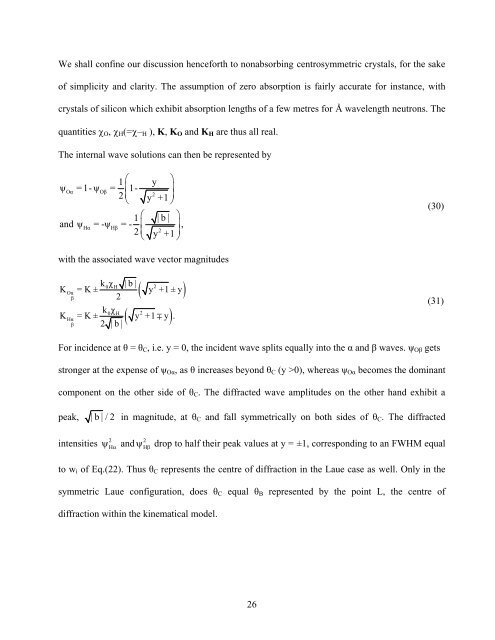PHYS01200804001 Sohrab Abbas - Homi Bhabha National Institute
PHYS01200804001 Sohrab Abbas - Homi Bhabha National Institute
PHYS01200804001 Sohrab Abbas - Homi Bhabha National Institute
Create successful ePaper yourself
Turn your PDF publications into a flip-book with our unique Google optimized e-Paper software.
We shall confine our discussion henceforth to nonabsorbing centrosymmetric crystals, for the sake<br />
of simplicity and clarity. The assumption of zero absorption is fairly accurate for instance, with<br />
crystals of silicon which exhibit absorption lengths of a few metres for Å wavelength neutrons. The<br />
quantities O , H (=– H ), K, K O and K H are thus all real.<br />
The internal wave solutions can then be represented by<br />
1 y<br />
ψ<br />
Oα<br />
= 1- ψ<br />
Oβ<br />
= 1-<br />
<br />
<br />
2<br />
2<br />
y +1<br />
<br />
<br />
<br />
1 | b | <br />
and ψ<br />
Hα<br />
= -ψ<br />
Hβ<br />
= - ,<br />
2 2<br />
y +1 <br />
<br />
(30)<br />
with the associated wave vector magnitudes<br />
k χ | b |<br />
Oα<br />
β<br />
K = K ±<br />
0 H<br />
2<br />
y +1 ± y<br />
2<br />
k0χ<br />
H<br />
K<br />
Hα<br />
= K ±<br />
β<br />
<br />
2<br />
y +1 y .<br />
2 | b |<br />
<br />
<br />
(31)<br />
For incidence at θ = θ C , i.e. y = 0, the incident wave splits equally into the α and β waves. ψ Oβ gets<br />
stronger at the expense of ψ Oα , as θ increases beyond θ C (y >0), whereas ψ Oα becomes the dominant<br />
component on the other side of θ C . The diffracted wave amplitudes on the other hand exhibit a<br />
peak,<br />
| b | / 2 in magnitude, at θ C and fall symmetrically on both sides of θ C . The diffracted<br />
intensities<br />
2<br />
<br />
H<br />
and 2 H<br />
drop to half their peak values at y = ±1, corresponding to an FWHM equal<br />
to w i of Eq.(22). Thus θ C represents the centre of diffraction in the Laue case as well. Only in the<br />
symmetric Laue configuration, does θ C equal θ B represented by the point L, the centre of<br />
diffraction within the kinematical model.<br />
26
















